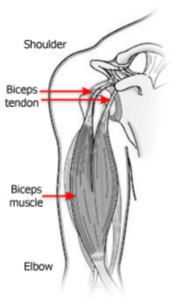Biceps Tendinitis of the Shoulder
Biceps tendinitis is an inflammation or irritation of the biceps tendon, which connects the biceps muscle to the shoulder.
Anatomy
The biceps muscle is located in the front area of the upper arm. The biceps muscle helps to stabilize the large bone in the upper arm (the humerus) in the shoulder socket. It also helps to accelerate and decelerate the arm during overhead activities, like tennis or pitching.

The biceps tendons keep the biceps muscle attached to the shoulder at one end and the elbow at the other end.
Tendons are strong cord-like structures that connect each end of the biceps muscle to bones. At one end of the biceps muscle, tendons connect the biceps to the shoulder in two places. At the other end of the muscle, tendons connect the biceps muscle to the smaller bone (radius) in the lower arm.
Cause
Injuries to the biceps tendons are often caused by repetitive overhead activity. Overuse, aging, and stress can cause the tendon to deteriorate, even if there is no inflammation present.
Symptoms
Symptoms include:
- Pain when the arm is overhead or bent.
- Localized tenderness as the tendon passes over the groove in the upper arm bone.
- Occasionally, a snapping sound or sensation in the shoulder area.
Diagnosis
During the physical examination, the doctor will assess the shoulder area for range of motion. He or she will look for any tenderness and signs of instability.
Sometimes, the doctor may want to use X-rays or magnetic resonance imaging (MRI) to look inside the joint for other conditions or tendon injuries that might cause the pain.
Treatment
Nonsurgical Treatment
Treatment generally does not start with surgery. The first step is to rest the arm and shoulder by temporarily switching to another sport or activity that does not include overhead activity. Ice applications and nonsteroidal anti-inflammatory medications, such as ibuprofen, can help reduce inflammation. The physician may recommend stretching and progressive strengthening exercises to build muscle endurance and restore range of motion. Overhead activity can be resumed gradually.
Surgical Treatment
Arthroscopic surgery may be considered if pain results from shoulder instability or from pressure on the tendon from the shoulder bones. Arthroscopy uses fiberoptic technology and small instruments to examine the shoulder joint and anchor the tendon properly.
Rehabilitation
After surgery, the orthopaedic surgeon will prescribe a rehabilitation program that includes stretching and strengthening exercises. Early movement is important, but you should wait for your physician’s approval before doing any heavy lifting or before returning to sports.
